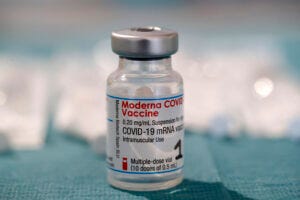Content Spotlight
Podcast: MilliporeSigma says education vital to creating unbreakable chain for sustainability
MilliporeSigma discusses the importance of people, education, and the benefits of embracing discomfort to bolster sustainability efforts.

Moderna says it is addressing the rising cost of goods from underutilized COVID vaccine capacity by downsizing its manufacturing network.
Moderna’s rise to the dizzying heights of Big Biopharma status came through its rapid response to the COVID-19 pandemic. It’s vaccine Spikevax – the second messenger RNA (mRNA) product to win approval – brought in $7.7 billion in 2021 and $18.4 billion in 2022. (For context, Moderna’s pre-pandemic revenue in 2019 stood at $60 million).
To support sales, the company built up an impressive manufacturing network both inhouse and through third parties. But as the pandemic has turned into an endemic, demand for vaccines has plummeted, resulting in predicted sales of between $6-8 billion for 2023, depending on COVID vaccination rates in the US. This has not changed, despite the approval this week of an updated version of Spikevax to tackle multiple circulating variants of COVID.

COVID-19 vaccination center. Moderna COVID-19 vaccine ready for vaccinations. France.
“We built a very large manufacturing footprint during the pandemic because we had to in terms of saving lives, getting people back to living a normal life, like meeting together physically and also, of course, [while] maximizing the business opportunities that were ahead of us,” Moderna CEO Stephane Bancel said this week.
“We knew that coming down from the pandemic we were going to be oversized,” he told delegates at the Morgan Stanley Global Healthcare Conference. “If you take out the onetime drivers, the cost of goods was around 20%, like it was before. But when you add the write-offs we had for the old vaccine, 1273 that we didn’t need anymore, and the unused capacity at the partners we have, that drove down the gross margin.”
Along with multiple investments at its own production site in Norwood, Massachusetts, Moderna inked a series of short and long-term deals with contract development and manufacturing organizations (CDMOs) during the height of the pandemic. Partners during the peak of the pandemic included Resilience, Catalent, Lonza, Aldevron, Thermo Fisher, and Samsung Biologics.
“What we are doing as we speak is actually working to downsize our manufacturing footprint across the board to get our gross margin back to where it should be, according to industry standards and so on.”
Further details were not shared, but speaking Wednesday at Moderna’s R&D Day, James Mock, CFO, said cost of goods sold in 2023 was elevated to around $3.5-4 billion – representing up to 75% of expected sales – but efforts are being taken to reduce this significantly.
“As we transition from a pandemic to an endemic market, it was a difficult exercise to understand what that volume [of COVID vaccine needed] will be. And based on our estimates of what we think that volume will be, we probably overproduced a little bit too much this year, which is why we have excessive unutilized capacity and excessive materials, and that will come down.”
He continued: “We built for a pandemic environment and that also means that we have too much of a manufacturing footprint. And we are hard at work resizing that right now as we speak to try to get that rightsized for the next couple of years so that you should see that cost of good line come down.”
Beyond Norwood, Moderna laid plans for manufacturing facilities outside the US, including in Canada, Kenya, and the UK.
It is unclear if these facilities will be part of Moderna’s capacity downsize plans.
However, a 60,000 square-foot plant in Marlborough, Massachusetts being constructed for $322 million will continue to form part of Moderna’s future manufacturing plans.
According to Bancel, the plant will support Moderna’s individualized neoantigen therapies (INTs), cancer mRNA vaccines being codeveloped with Merck & Co. designed specifically for individual patients. Lead candidate is mRNA-4157 (V940) in combination with Merck’s Keytruda (pembrolizumab) in Phase III trials.
The firm is filing for accelerated approval and Bancel said he does not want to be in a position where this is granted but Moderna is unable to begin sales due to a lack of approved capacity.
“We are building the Marlborough site so that we can launch out of there. But when you submit approval, you need to submit your CMC package. And for your CMC package, you need to have something built and be clear how you’re going to do it.”
You May Also Like